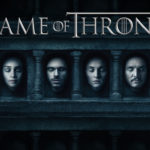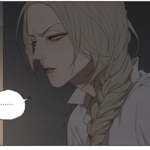 Against Hope sounds fantastic, intriguing, and badass like John Wick, but with Nazis. However, what seems like just another “bloody revenge” story turns out to be so much more than that. We follow Hope, the protagonist, through years of her life, and by the end of the book, we know her intimately. It’s brutal, yes, but also heartwrenching and hopeful.
Against Hope sounds fantastic, intriguing, and badass like John Wick, but with Nazis. However, what seems like just another “bloody revenge” story turns out to be so much more than that. We follow Hope, the protagonist, through years of her life, and by the end of the book, we know her intimately. It’s brutal, yes, but also heartwrenching and hopeful.
Víctor Santos, writer and artist of Against Hope, was kind enough to sit down with Rogues Portal to discuss his upcoming graphic novel, what his process looks like, and what he thinks attracts people to this kind of story.
Against Hope will be released on June 3, 2020, from Dark Horse Comics.
Rogues Portal (RP): One question I always have to ask first concerns the process. What goes into making a comic? You write and draw Against Hope. Do you separate those two things and start drawing after you finished the script, or is it more like one singular motion, so to speak?
Víctor Santos (VS): Well, Against Hope is a particular case, because I began it as a very simple webcomic that became something very different later. I had a very basic approach; basically the survival story plot story set in the ’80s: A young Afro-American girl trying to survive an evil manhunt game of a Neo-Nazi family. I worked on it like a storyboard sequence, drawing first and adding dialogue later. But the concept was growing, so I added the other plot in a more traditional way, the ’90s story, and then I began to add layers of different timelines. Basically, it’s the story of revenge throughout a period of years told using different timelines, where some events and dialogue reverberate in future and past. So basically, I’m drawing, writing, coloring, and lettering at the same time, layer by layer, moving sequences like in a movie cut. It’s a very organic way to work, and it’s something I can do because I’m the sole artist here. I never would do this crazy thing when I write a script for another artist.
RP: The format of Against Hope is distinct from the typical graphic novel, which I appreciated. It feels fresh and allows for a more experimental approach. What triggered the decision to do the comic in a landscape format?
VS: I enjoyed doing the same thing with the Polar books a lot. I find it truly natural. We see the world in “landscape format.” When you leave home and go outside, your sight doesn’t scan the street to up to down; you usually move your eyes from left to right and right to left … So in a visual medium, it seems the more fluent choice. At the same time, I love doing the page composition; it’s a subject in comics I’m obsessed with. And I produce a lot of comics too. I love working on two, three projects at the same time. So when you are working on a lot of pages, having some of them in a different format is refreshing. I think comicbooks and graphic novels should have different formats, square, bigger, and smaller books. It’s an advantage we have, and we don’t exploit it. Movies are limited by the home screen limits. Our only limit is the size of our shelves (laughs). Surely Chris Ware has a word or two to say about it (laughs).
RP: The further the story of Against Hope continues, the more the different timelines intertwine, especially thematically. The way they take place almost simultaneously is something you can only do in comics. However, they are also very distinct from one another. How did you choose the color palette for each of them?
VS: As I told you, the concept grew like the layers of an onion. Basically, I had two major timelines. I used a colored inkwash style in the ’80s timeline because I wanted to recall some ’80s painted comicbooks. Not specifically one title, but that vibe, when paper quality and printing began to improve and colorists tried to do more daring things. And the ’90s timeline has a more anime or animation style, making it clearly digital.
After those two, I colored the additional minor timelines using a process of elimination, choosing the graphic elements (ink lines, color palettes or styles of brushes or degrees) to create a contrast with the others.
It was a headache, sometimes, but these challenges are the reason I love this artistic field.
RP: The resourcefulness of the main character reminded me of movies like John Wick or The Equalizer. She does not just fight the bad guys because she can but has a profound personal reason for everything she does. What inspired you to write this story with this main character?
VS: I like the archetypal characters, the kind of pulpy stuff you can find in cheap novels, western movies, or samurai films. I’m obsessed with that imagery, the mythological figures, Jung and Campbell’s stuff … This kind of lonely avenger is one of them, and I like to explore different facets of these heroic figures.
I had even worked with different races and genre heroes in other books like in Polar, so I wanted to establish a different kind of main character here. In Polar, you mainly have the Black Kaiser, a mature skilled man. When the story begins, he’s a legend. I wanted to create a heroine with a story telling how she became a legend.
RP: What do you suppose attracts people to the “bloody revenge” genre?
VS: It’s cathartic. We live in a world of injustice, and, sometimes, we wish for an easy solution. “We just should kill all those corrupt politicians,” you know. But I’m conscious this is not the solution. Right now, you can think of a lot of people offering easy solutions to every problem, but if you have minimum experience, you know simple solutions don’t fix complex problems. They don’t work in the real world.
But these stories — these “simulations” — let us speak about it with perspective. Good revenge stories have great action and violence and dark humor, but I think good revenge stories also talk about the consequences of violence too. Hope Walker, my character, has to pay a price even if she wins. A price in her sanity, a price in her relationship with her loved ones … I’m not trying to lecture about either, but I like to put these things subtly, sometimes with little visual details or seemingly trivial bits of dialogue.
RP: What are you currently reading or watching?
VS: I basically read creator-owned comics. If I buy some DC or Marvel stuff, it’s because I’m fan of some specific artist or writer. Self-contained things like The Vision, Batman: The Golden Child, or even Don Rosa’s Scrooge McDuck!
I buy every Warren Ellis creator-owned book, like Trees, Injection … I recently enjoyed his Cemetery Beach with Jason Howard. My latest purchases are books like Head Lopper, Criminal, the Mike Oeming’s Dick Tracy, the G.I. Joe Sierra Muerte by Michel Fiffe, and the new Matt Wagner Mage series. I love classic genre things with a personal approach.
TV shows or movies I’ve been watching … I’m currently watching Hunters and enjoyed Treadstone, The Undone, and The Expanse in Amazon. On Netflix, I follow Brooklyn 99, The Good Place, Mindhunter, The Umbrella Academy, and Peaky Blinders amongst others. I’m a Whovian, too. I hated Joker, but I loved Jojo Rabbit. And, lately, I have a weird obsession for Scott Adkins’s B-movies.
RP: And finally, some quick questions: How would you describe Against Hope with one word?
VS: I hate these kind of questions! (laughs). But I choose “Hope” over “Revenge.”
RP: Your weapon of choice?
VS: When I was a child, I owned a homemade nunchuck, because I was a fan of the Ninja Turtles. Surely the less practical weapon in the history of war. I think now I would choose a katana, because I learned a little of kendo in college, and I love samurai/chambara films … But surely I would cut my own arm in the first movement.
RP: How should the world end: Zombie-Apocalypse or Alien-Invasion?
VS: I would prefer Alien-Invasion, because I would win an old bar argument. But sincerely, I think we will collapse as civilization in a very stupid and unnecessary way.
RP: Least favorite thing to put on a pizza?
VS: I have classical hate habits: Pineapple.
RP: Dogs or cats?
VS: I’m not an animal guy, but I choose dogs. Cats are evil aliens from outer space, everybody knows that.
RP: Thank you for taking the time and answering my questions!
VS: It’s always a pleasure to practice my broken English!
This interview has been edited for clarity.


![[REVIEW] RED SONJA #1](https://geekd-out.com/wp-content/uploads/2021/08/EA7001C0-7654-4A66-9242-B5DA09196760-150x150.jpeg)

One thought on “[INTERVIEW] VICTOR SANTOS TALKS ABOUT HIS UPCOMING GRAPHIC NOVEL “AGAINST HOPE””